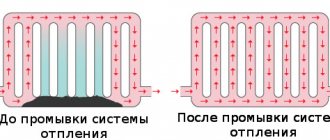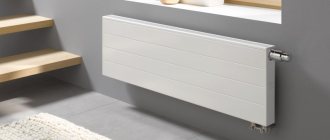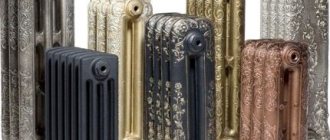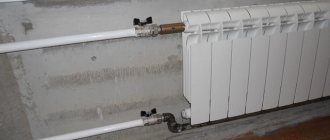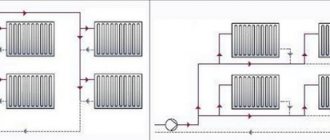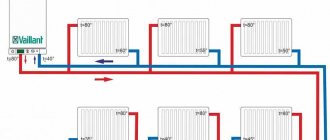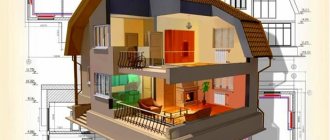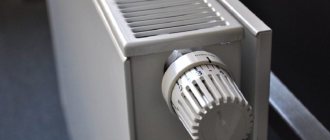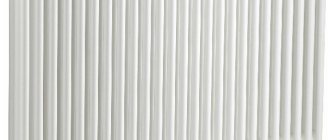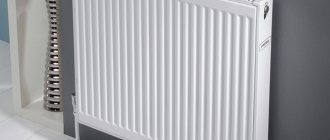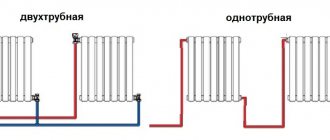Are you planning to change the heating appliances in your own home? For this, knowledge about the types of battery wiring, methods of connecting and placing them will be useful. Agree, because the correctness of the selected connection diagram for heating radiators in a particular house or room directly determines its effectiveness.
Correctly connecting the batteries is a very important task, because it can provide all rooms with a comfortable temperature at any time of the year. It’s good when fuel consumption is minimal and your home is warm on the coldest days.
We'll help you understand what you need to get your radiators running as efficiently as possible. In the article you will find a lot of useful information about ways to connect batteries and their implementation without the involvement of specialists. Diagrams and videos are provided that will help you clearly understand the essence of the issue.
Types of heating systems
The amount of heat that the heating radiator will emit depends not least on the type of heating system and the selected type of connection. To choose the best option, you must first understand what kind of heating systems there are and how they differ.
Monotube
A single-pipe heating system is the most economical option in terms of installation costs. Therefore, this type of wiring is preferred in multi-storey buildings, although in private buildings such a system is far from uncommon. With this scheme, the radiators are connected to the main line in series and the coolant first passes through one heating outlet, then enters the input of the second, and so on. The output of the last radiator is connected to the input of the heating boiler or to the riser in high-rise buildings.
Example of a one-pipe system
The disadvantage of this wiring method is the impossibility of adjusting the heat transfer of radiators. By installing a regulator on any of the radiators, you will regulate the rest of the system. The second significant drawback is the different coolant temperatures on different radiators. Those that are closer to the boiler heat up very well, those that are further away become increasingly colder. This is a consequence of the serial connection of heating radiators.
Two-pipe wiring
A two-pipe heating system is distinguished by the fact that it has two pipelines - supply and return. Each radiator is connected to both, that is, it turns out that all radiators are connected to the system in parallel. This is good because the coolant of the same temperature enters the input of each of them. The second positive point is that you can install a thermostat on each of the radiators and use it to change the amount of heat it emits.
The disadvantage of such a system is that the number of pipes when laying out the system is almost twice as large. But the system can be easily balanced.
Connection features
Methods for connecting radiators
When installing heating systems in private homes, the following connection methods are used:
In this case, the supply pipe is connected from above, and the return pipe is connected from below to the same section. This connection diagram for the heating battery allows the radiator to heat up evenly. However, if the accordion has a large number of sections, then significant heat loss will occur, so it is better to use other connection options.
Saddle and bottom
This method is an excellent option for cases where pipes run through the floor. The connection is made to the pipes located at the bottom of the structure, in opposite sections. The only disadvantage of this method is its low efficiency, since heat loss can reach 15 percent.
Used when connecting devices with a large number of sections. As you might guess, the inlet pipe in this case is connected from above, and the outlet pipe from below, in the opposite section. This scheme for connecting heating radiators in a private house promotes uniform distribution of coolant and maximum heat transfer from appliances.
Note! When using a thermostat for heating parallel to the radiator, a bypass must be installed. This will allow you to regulate the degree of heating of the device.
Radiator connection diagram
As we can see, the methods for connecting heating radiators depend on a number of factors, such as the method of laying pipes, the power of the equipment, etc. In particular, the type of system is of great importance. We will talk in more detail about the types of heating systems below.
Single-pipe system diagram
Types of system
When installing heating systems, two schemes are used:
- Single-pipe - is the simplest, since the coolant circulates through one pipe, to which heating devices are connected in series. Its disadvantage is that it does not allow you to regulate the heat supply. Therefore, heat transfer corresponds to the design norm laid down during the design. This scheme is used in small systems, since with a long pipeline and a large number of radiators, the devices will heat up unevenly.
- Double-pipe - its meaning is that hot water flows through one pipe, and cooled water returns to the boiler through the other. In this case, heating batteries are connected in a private house, respectively, in parallel. The advantage of such a device is the uniform heating of the sections, as well as the ability to adjust the heat transfer. The only drawbacks that can be identified are the need for more pipes; accordingly, the cost of the structure increases.
Diagram of a two-pipe system
It should be noted that, regardless of the type of system, connecting heating batteries with your own hands can be done in two ways:
- According to the vertical scheme, the heating device is connected to a vertical riser, from which wiring is carried out to the radiators.
- According to the horizontal scheme, the coolant circulates through horizontal pipelines.
The choice of heating battery connection diagram depends on the characteristics of the house. For example, if the housing contains several floors, then the connection is realized according to a vertical scheme.
In the photo there is a radiator located under the window
What does it take for batteries to work efficiently?
An efficient heating system can save money on fuel costs. Therefore, when designing it, you should make informed decisions. After all, sometimes the advice of a neighbor in the country or a friend who recommends a system like his is not at all suitable.
It happens that there is no time to deal with these issues yourself. In this case, it is better to turn to professionals who have been working in this field for at least 5 years and have grateful reviews.
Image gallery
Photo from
Marking the wall and installing brackets
Position control before fastening
Connecting the radiator to the supply pipe
Connecting the radiator to the return pipe
When deciding to install new batteries or replace heating radiators yourself, you need to take into account that their efficiency is directly affected by the following indicators:
- size and thermal power of heating devices;
- their location in the room;
- connection method.
The choice of heating devices amazes the imagination of the inexperienced consumer. Among the offers are wall-mounted radiators made of various materials, floor and baseboard convectors. They all have different shapes, sizes, heat transfer levels, and connection types. These characteristics must be taken into account when installing heating devices into the system.
Among the models of heating devices on the market, it is better to choose based on the material and thermal power specified by the manufacturer
For each room, the number of radiators and their size will be different. It all depends on the area of the room, the level of insulation of the external walls of the building, the connection diagram, the thermal power indicated by the manufacturer in the product passport.
The location of the batteries is under the window, between windows located at a fairly long distance from each other, along a blank wall or in the corner of the room, in the hallway, pantry, bathroom, in the entrances of apartment buildings.
Depending on the location and method of installation of the heating device, there will be different heat losses. The worst option is a radiator completely covered with a screen
It is recommended to install a heat-reflecting screen between the wall and the heating device. You can make it yourself using one of the heat-reflecting materials - penofol, isospan or another foil analogue.
You should also adhere to the following basic rules for installing a battery under a window:
- all radiators in one room are located on the same level;
- convector fins in a vertical position;
- the center of the heating equipment coincides with the center of the window or is 2 cm to the right (to the left);
- the length of the battery is at least 75% of the length of the window itself;
- the distance to the window sill is at least 5 cm, to the floor - no less than 6 cm. The optimal distance is 10-12 cm.
The level of heat transfer from devices and heat loss depends on the correct connection of radiators to the heating system in the house.
By following the basic standards for the placement of radiators, you can maximally prevent the penetration of cold into the room through the window
It happens that the owner of a home is guided by the advice of a friend, but the result is not at all as expected. Everything is done like his, but the batteries don’t want to heat up.
This means that the selected connection diagram was not suitable specifically for this house, the area of the premises, the thermal power of the heating devices were not taken into account, or annoying mistakes were made during installation.
Serial connection of two heating radiators
sansvar wrote. What the customer bought, I delivered. the number of sections and location, the choice made in advance before my recommendations and advice. For example, I actually suggested that he put one instead of two, well, I don’t like the diagonal connection. It’s kind of ugly, there’s a lot of “extra” pipes
Yes, I realized this right away, I’ve seen loads of them like that, by the way, I know that there are weirdos, enough.
sansvar wrote. You can’t put the tap on bypass, I’m just not one of those people... if something is very critical in the customer’s desires, I refuse even for an additional payment
And it is right.
I'll bring up the topic. From the developer we have two steel panel radiators Maxterm type 22 (double-row, double-panel) with bottom connections (apartment wiring, Bir Pex). In appearance, they seem to have bypasses (they didn’t answer anything about this on the manufacturer’s website). No, I’m lying. Answered:
Please tell me, when the thermal valve is closed, the coolant bypasses the radiator (the coolant flow remains constant) or the thermal valve simply blocks the coolant flow. Thanks in advance for your answer. Yes. The thermostatic head regulates the flow through the radiator through the valve stem. Those. regulates the coolant flow through the radiator. And the constant flow through the system is maintained. Moreover, if all radiators operate to limit flow, then the system resistance increases. And in this case a bypass must be provided.
My task is to modernize the distribution of heating pipes in the apartment in order to ultimately get as few intersections and joints of pipes as possible. There is already one piece of advice to replace my Wishlist with a collector circuit. But I can’t understand why it is believed that water shunted through the bypass (after all, there are very strong suspicions of its presence) will poorly heat the second radiator?
Registration: 03/25/2011 Penza Messages: 7080
12/10/2013 at 16:18
Loki wrote. we have two steel panel radiators Maxterm type 22 (double-row, double-panel) with bottom connection
Loki wrote. have bypasses (nothing was answered about this on the manufacturer’s website)
Bypasses are used only in single-pipe heating systems. And they don't happen inside radiators. There are bottom connection fittings with built-in bypasses.
Draw a general diagram of the heating system in the apartment. Without it, it is unclear whether you have a one-pipe or two-pipe system. Also indicate the brand of radiator bottom connection fittings used.
Loki wrote. Will the second radiator heat up badly?
If the pressure difference on the supply and output lines (supply/return) is sufficient, then the radiators will heat normally, provided that the hydraulics of the entire residential heating system are calculated and rebalanced with adjustment. Because connecting an additional radiator will introduce an imbalance in the operation of the apartment’s heating system.
It is not possible to answer how critical the imbalance will be without carrying out hydraulic calculations.
Hydraulic calculation of heating systems. Heat calculation (calculation of insulation) of houses and apartments.
Sergants. poorly legible photo. But from what I was able to see, I conclude that the system is two-pipe.
It is better to install a floor (in-floor) convector of sufficient power under the window. Then there will be no need for additional radiators.
Sergants wrote. And is it possible to leave the fittings that are in place now?
It is strange that there is a regular ball valve on the return line, instead of a shut-off valve. Then the thermal valve under the blue cap should have presets. If so, then leave it and do not upset the design presets.
Hydraulic calculation of heating systems. Heat calculation (calculation of insulation) of houses and apartments.
Connecting a radiator to a single-pipe heating system
“Leningradka” is the most common, cost-effective single-pipe heating system (see diagram). It is used in apartments and small houses. It can be vertical - in the entrances of a house between floors, and horizontal - in a room or on the same floor.
Radiators with bottom and top connections can be connected to a single-pipe heating system. If the radiator has a bottom wiring, then the coolant is installed below the level of the heating devices, pipes run horizontally from it, which then rise up to the radiators. For radiators with top wiring, on the contrary, the coolant is installed at the highest point of the heating system, and water circulates from there.
Only in single-pipe heating circuits are valves used to shut off the water. They are located in so-called branch sections, the volume of which is several times smaller than the main pipes of the heating system.
Single-pipe
The operating principle of a single-pipe heating system is circular circulation of liquid along one line. The heated coolant leaves the boiler and passes sequentially through each connected convector.
Each subsequent one receives water from the previous one; as it passes through, part of the heat is lost as a result of cooling. The further the battery is from the boiler, the lower its temperature. If one element fails, the operation of the entire circuit is disrupted.
To avoid this, it is recommended to install the wiring with a bypass path.
Installation is carried out horizontally or vertically ; in the second case, it is optimal to install the boiler at the lower level to ensure natural circulation of liquid.
Advantages of a single-pipe scheme: ease of installation, low cost of consumables, aesthetics (with horizontal wiring, the pipe can be hidden, for example, mounted under the floor).
Flaws:
- Interconnection of circuit elements - failure of one radiator leads to disruption of the entire system;
- High heat loss;
- Inability to control the heating of individual elements of the system;
- Limited heating area (up to 150 m2).
However, for a one-story house with a small area, it is more rational to choose this type of heating.
What is the importance of choosing a radiator installation location?
Regardless of whether the heating radiators are connected in series or in parallel, the functional purpose of these devices is not only to heat the room. By means of batteries, a certain protection (screen) is created from the penetration of cold from the outside. This is precisely what explains the location of the batteries under the window sills. With this distribution of radiators in places of greatest heat loss, that is, in the area of window openings, an effective thermal curtain is created.
There simply cannot be a battery in this place. With its help, a barrier is created to the cold air from the street
Before considering ways to connect heating radiators, it is necessary to draw up a diagram of the location of these devices
It is important to determine the correct installation distances for radiators, which will ensure their maximum heat transfer. So, the heating batteries are absolutely correctly positioned if:
- lowered from the bottom of the window sill by 100 mm;
- are located at a distance of 120 mm from the floor;
- spaced from the wall at a distance of 20 mm.
Violating these standards is strictly not recommended.
Radiator installation
radiator installation
Radiators should be installed in places with the greatest temperature difference , that is, near windows and doors. It is necessary to place the heater under the window in such a way that their centers coincide. The distance from the device to the floor must be at least 120 mm, to the window sill - 100 mm, to the wall - 20-50 mm.
Installation of the battery to the pipeline is carried out using fittings (angle, coupling combined with thread) and an American ball valve, using soldering or welding. An air outlet (Mayevsky valve) is installed on one of the other holes, and the remaining hole is closed with a plug.
Before filling the system, carry out a first test run to clean it and check for leaks. The water should be left for several hours, then drained. After this, fill the system again, increase the pressure using the pump and bleed air from the radiator until water appears, then turn on the boiler and begin heating the room.
Common installation errors: incorrect placement of the convector (close to the floor and wall), mismatch in the number of heater sections and connection type (side connection type for batteries with more than 15 sections) - in this case, the room will be heated with less heat transfer.
Liquid splashing out of the tank indicates its excess, noise in the circulation pump indicates the presence of air - these problems are eliminated using a Mayevsky tap.
Series connection of heating radiators
With this method, the batteries are connected using one pipe. Most often, if a series connection of heating radiators is required, then in order to increase the power of the heating devices and ensure a sufficient degree of heating of the room, it is necessary to increase the number of sections at the end of the line.
The series connection method is characterized by uneven distribution of thermal power. As a result, the first radiator heats up much hotter than the subsequent ones, and the last device in the circuit will be barely warm.
Despite a number of inconveniences, this method is in demand because of its simplicity, and adjustment of the required degree of heat transfer is carried out by building up several sections of batteries in different places of the heating structure. Examples of connecting heating radiators in the video:
About connecting batteries to pipelines
If previously the choice of heating devices and accessories for them was small, now there are enough new products on the market that make our utility networks look more aesthetically pleasing. Nowadays you can purchase a nice kit for connecting batteries for each product; it may include many useful accessories: valves, valves, thermal heads and other elements for quick and convenient assembly of the heater.
For example, a kit for connecting heating radiators, which includes an entire unit with control fittings. It is relevant when the device is connected to the network sideways and is additionally equipped with a valve for the thermal head:
Aluminum and bimetallic radiators with bottom connections of the supply and return pipelines have also become very popular. Such products are created for connection to pipes laid hidden in the floor and their cost is more expensive than usual. Despite this, these devices are mounted together with openly laid pipelines, adding a proprietary bottom connection unit, as shown below.
The design of the batteries has one peculiarity: the water first passes from the bottom up through the first section, and then spreads over all the others, as with a conventional top connection, which is very convenient. But at the same time, radiators with bottom connections have the disadvantage of incorrect adjustment from the thermal head. You can install it, but the element will react to the air temperature near the floor.
Application
All of the above schemes can be applied in a private home. If desired, you can use two heating sources: a boiler built into the stove and a gas or electric boiler, which is connected in parallel.
Let's consider the correctly executed sequence of installation of a single-pipe heating system in a private house:
- installation of a heating boiler;
- finishing the walls where the battery is installed, thermal insulation if necessary;
- installation of radiators on walls;
- determination of places for attaching pipes and tapping branches;
- filling the system with water and performing a test run.
The connection of heating radiators can be flow-through and with closing sections. The first method is simpler, requires less materials and labor, and is used for small systems. The second method allows you to regulate the coolant supply for each individual radiator, but requires the installation of additional bypass sections - bypasses. Additional shut-off valves are also required here.
Installation materials and tools
To install radiators yourself, you need to prepare tools for attaching radiators. Also special equipment for installing a heating system.
When attaching and assembling heating batteries you will need:
- hammer drill or impact drill;
- a set of keys;
- construction or laser level, you can use a water level;
- tape measure, marker or pencil;
- sealant.
When using polypropylene pipes, you need a special soldering iron for welding PP. With it you can easily and quickly solder polypropylene pipes.
Materials for connecting radiators:
- Brackets. For mounting the device on the wall.
- Mayevsky crane. Bleeds air from the system.
- Stub. Closes an unused hole.
- Cranes. To adjust the amount of coolant or shut it off completely.
Everything except the shut-off valves is included with the heating device. Or such sets can be purchased separately.
What is the importance of choosing a radiator installation location?
Regardless of whether the heating radiators are connected in series or in parallel, the functional purpose of these devices is not only to heat the room. By means of batteries, a certain protection (screen) is created from the penetration of cold from the outside. This is precisely what explains the location of the batteries under the window sills. With this distribution of radiators in places of greatest heat loss, that is, in the area of window openings, an effective thermal curtain is created.
There simply cannot be a battery in this place. With its help, a barrier is created to the cold air from the street
Before considering ways to connect heating radiators, it is necessary to draw up a diagram of the location of these devices
It is important to determine the correct installation distances for radiators, which will ensure their maximum heat transfer. So, the heating batteries are absolutely correctly positioned if:
- lowered from the bottom of the window sill by 100 mm;
- are located at a distance of 120 mm from the floor;
- spaced from the wall at a distance of 20 mm.
Violating these standards is strictly not recommended.
Serial connection of two heating radiators
sansvar wrote. What the customer bought, I delivered. the number of sections and location, the choice made in advance before my recommendations and advice. For example, I actually suggested that he put one instead of two, well, I don’t like the diagonal connection. It’s kind of ugly, there’s a lot of “extra” pipes
Yes, I realized this right away, I’ve seen loads of them like that, by the way, I know that there are weirdos, enough.
sansvar wrote. You can’t put the tap on bypass, I’m just not one of those people... if something is very critical in the customer’s desires, I refuse even for an additional payment
And it is right.
I'll bring up the topic. From the developer we have two steel panel radiators Maxterm type 22 (double-row, double-panel) with bottom connections (apartment wiring, Bir Pex). In appearance, they seem to have bypasses (they didn’t answer anything about this on the manufacturer’s website). No, I’m lying. Answered:
Please tell me, when the thermal valve is closed, the coolant bypasses the radiator (the coolant flow remains constant) or the thermal valve simply blocks the coolant flow. Thanks in advance for your answer. Yes. The thermostatic head regulates the flow through the radiator through the valve stem. Those. regulates the coolant flow through the radiator. And the constant flow through the system is maintained. Moreover, if all radiators operate to limit flow, then the system resistance increases. And in this case a bypass must be provided.
My task is to modernize the distribution of heating pipes in the apartment in order to ultimately get as few intersections and joints of pipes as possible. There is already one piece of advice to replace my Wishlist with a collector circuit. But I can’t understand why it is believed that water shunted through the bypass (after all, there are very strong suspicions of its presence) will poorly heat the second radiator?
Registration: 03/25/2011 Penza Messages: 7080
12/10/2013 at 16:18
Loki wrote. we have two steel panel radiators Maxterm type 22 (double-row, double-panel) with bottom connection
Loki wrote. have bypasses (nothing was answered about this on the manufacturer’s website)
Bypasses are used only in single-pipe heating systems. And they don't happen inside radiators. There are bottom connection fittings with built-in bypasses.
Draw a general diagram of the heating system in the apartment. Without it, it is unclear whether you have a one-pipe or two-pipe system. Also indicate the brand of radiator bottom connection fittings used.
Loki wrote. Will the second radiator heat up badly?
If the pressure difference on the supply and output lines (supply/return) is sufficient, then the radiators will heat normally, provided that the hydraulics of the entire residential heating system are calculated and rebalanced with adjustment. Because connecting an additional radiator will introduce an imbalance in the operation of the apartment’s heating system.
It is not possible to answer how critical the imbalance will be without carrying out hydraulic calculations.
Hydraulic calculation of heating systems. Heat calculation (calculation of insulation) of houses and apartments.
Sergants. poorly legible photo. But from what I was able to see, I conclude that the system is two-pipe.
It is better to install a floor (in-floor) convector of sufficient power under the window. Then there will be no need for additional radiators.
Sergants wrote. And is it possible to leave the fittings that are in place now?
It is strange that there is a regular ball valve on the return line, instead of a shut-off valve. Then the thermal valve under the blue cap should have presets. If so, then leave it and do not upset the design presets.
Hydraulic calculation of heating systems. Heat calculation (calculation of insulation) of houses and apartments.
Other types of connection
There are more profitable options than the bottom connection, which reduce heat loss:
- Diagonal. All experts have long come to the conclusion that this type of connection is ideal regardless of the piping scheme in which it is used. The only system where this type cannot be used is a horizontal bottom single-pipe system. That is, the same Leningrad woman. What is the essence of a diagonal connection? The coolant moves diagonally inside the radiator - from the upper pipe to the lower. It turns out that hot water is evenly distributed throughout the entire internal volume of the device, falling from top to bottom, that is, naturally. And since the speed of water movement is not very high during natural circulation, the heat transfer will be high. Heat loss in this case is only 2%.
- Lateral, or one-sided. This type is very often used in apartment buildings. The connection is made to the side pipes on one side. Experts believe that this type is one of the most effective, but only if the system has coolant circulation under pressure. There are no problems with this in city apartments. And to provide it in a private house, you will have to install a circulation pump.
What is the advantage of one type over others? In fact, correct connection is the key to effective heat transfer and reduced heat loss. But in order to connect the battery correctly, you need to prioritize.
Take, for example, a two-story private house. What to prefer in this case? Here are several options:
Two and one pipe systems
- Install a one-pipe system with side connection.
- Install a two-pipe system with a diagonal connection.
- Use a single-pipe scheme with lower wiring on the first floor and upper wiring on the second.
So you can always find options for connection diagrams. Of course, you will have to take into account some nuances, for example, the location of the premises, the presence of a basement or attic
But in any case, it is important to correctly distribute the radiators among the rooms, taking into account the number of their sections. That is, the power of the heating system will have to be taken into account even with such an issue as the correct connection of radiators
In a one-story private house, connecting the battery correctly will not be very difficult, given the length of the heating circuit. If this is a single-pipe Leningrad circuit, then only a lower connection is possible. If it is a two-pipe scheme, then you can use a collector system or a solar one. Both options are based on the principle of connecting one radiator to two circuits - coolant supply and return. In this case, top pipe distribution is most often used, where distribution along the circuits is carried out in the attic.
By the way, this option is considered optimal both in terms of operation and during the repair process. Each circuit can be disconnected from the system without turning off the latter. To do this, a shut-off valve is installed at the point where the pipes are separated. Exactly the same one is mounted after the radiator on the return pipe. You just have to close both valves to cut off the circuit. After draining the coolant, you can safely carry out repairs. In this case, all other circuits will operate normally.
Useful tips
Many people believe that the radiator connection option is not that important when it comes to heat dissipation. After all, much will depend on the type of heat source chosen. For example, bimetallic heating radiators have higher heat transfer than cast iron ones. But imagine that cast iron devices are installed according to the diagonal principle of coolant movement, and bimetallic ones are installed along the bottom. In the first case, heat loss is 2%, and in the second - 12%. The difference in losses is as much as 10%. For a heating system, this is a fairly high indicator, which will affect not only the indoor temperature, but also the amount of fuel consumed
This is very important for private houses
Today, experts give recommendations regarding increasing the heat transfer of devices. To do this, you can install a reflective panel on the wall behind the radiator, for example, a regular piece of fiberboard trimmed with aluminum foil. But keep in mind that the distance from the wall to the radiator in this case should be at least 1.5 cm.
Equipment price
Approximate calculation of equipment for the heating system of a house with an area of 100 m2.
| Name | quantity | Cost (rubles) |
| Boiler | 1 | 40.000 |
| Chimney | 2 m | 3.000 |
| Shut-off and connecting valves | 1 | 2.000 |
| Boiler room piping equipment | 1 | 2.000 |
| Radiator 10 sections | 6 | 36.000 |
| Radiator mounting kit | 6 | 1.800 |
| Mounting bracket | 24 | 1.000 |
| Pipe (polypropylene) | 60 m | 10.000 |
| Fittings (set) | 1 | 5.000 |
| Total: | 100.800 |
The cost of installation work by a master will cost approximately 50,000 - 60,000 rubles.
How to connect heating radiators
Radiator heating systems come in two types: single-pipe and double-pipe.
Single-pipe requires fewer pipes, but its main drawback: different coolant temperatures at the radiator inlet. It turns out that the one that is closer to the boiler heats up more, the one that is further away is weaker. In long-distance networks, it may happen that very cold coolant reaches the last radiator. This can often be observed on the first floors of high-rise buildings. A single-pipe system is usually used there, and the coolant is supplied from the upper floors down.
The figure shows a horizontal diagram of the serial connection of heating radiators; it is also called “single-pipe” and “Leningrad”. To allow for repairs, shut-off valves are installed on both sides of the heater. By closing them, you can remove, change and repair the radiator without stopping the entire system. A similar scheme is often used when connecting heating batteries in a private home. It is simply installed, and if the radiator is short in length, the heat transfer of each radiator is regulated using needle valves, which can be used to change the intensity of the coolant flow.
A single-pipe system is also called “series connection of heating radiators”
Two-pipe scheme - parallel connection of radiators to the supply. A coolant of the same temperature enters the inlet of each of them, and the cooled water is collected in another pipeline. And although the consumption of pipes (and money) during installation is greater, it is much easier to balance (adjust) the heat output of each heating device.
Two-pipe system - parallel connection of heating devices
Other types of connection
There are more profitable options than the bottom connection, which reduce heat loss:
- Diagonal. All experts have long come to the conclusion that this type of connection is ideal regardless of the piping scheme in which it is used. The only system where this type cannot be used is a horizontal bottom single-pipe system. That is, the same Leningrad woman. What is the essence of a diagonal connection? The coolant moves diagonally inside the radiator - from the upper pipe to the lower. It turns out that hot water is evenly distributed throughout the entire internal volume of the device, falling from top to bottom, that is, naturally. And since the speed of water movement is not very high during natural circulation, the heat transfer will be high. Heat loss in this case is only 2%.
- Lateral, or one-sided. This type is very often used in apartment buildings. The connection is made to the side pipes on one side. Experts believe that this type is one of the most effective, but only if the system has coolant circulation under pressure. There are no problems with this in city apartments. And to provide it in a private house, you will have to install a circulation pump.
What is the advantage of one type over others? In fact, correct connection is the key to effective heat transfer and reduced heat loss. But in order to connect the battery correctly, you need to prioritize.
Take, for example, a two-story private house. What to prefer in this case? Here are several options:
Two and one pipe systems
- Install a one-pipe system with side connection.
- Install a two-pipe system with a diagonal connection.
- Use a single-pipe scheme with lower wiring on the first floor and upper wiring on the second.
So you can always find options for connection diagrams. Of course, you will have to take into account some nuances, for example, the location of the premises, the presence of a basement or attic
But in any case, it is important to correctly distribute the radiators among the rooms, taking into account the number of their sections. That is, the power of the heating system will have to be taken into account even with such an issue as the correct connection of radiators
In a one-story private house, connecting the battery correctly will not be very difficult, given the length of the heating circuit. If this is a single-pipe Leningrad circuit, then only a lower connection is possible. If it is a two-pipe scheme, then you can use a collector system or a solar one. Both options are based on the principle of connecting one radiator to two circuits - coolant supply and return. In this case, top pipe distribution is most often used, where distribution along the circuits is carried out in the attic.
By the way, this option is considered optimal both in terms of operation and during the repair process. Each circuit can be disconnected from the system without turning off the latter. To do this, a shut-off valve is installed at the point where the pipes are separated. Exactly the same one is mounted after the radiator on the return pipe. You just have to close both valves to cut off the circuit. After draining the coolant, you can safely carry out repairs. In this case, all other circuits will operate normally.
Types of pipe routing
Connecting heating radiators in a private house can be done using a single-pipe or two-pipe scheme.
The first method is widely used in multi-storey buildings, in which hot water is first supplied through a supply pipe to the upper floors, after which, after passing through radiators from top to bottom, it enters the heating boiler, gradually cooling. Most often, in such a scheme there is natural circulation of coolant.
The photo shows a single-pipe diagram for connecting a radiator in an apartment with a bypass (jumper)
Its main advantages:
- Low cost and material consumption.
- Relatively easy to install.
- Compatible with underfloor heating systems and various types of radiators.
- Possibility of installation in rooms with different layouts.
- Aesthetic appearance due to the use of only one pipe.
- Difficulty in carrying out hydro- and heat calculations.
- The inability to regulate the heat supply on a separate radiator without affecting the others.
- High level of heat loss.
- Increased coolant pressure is required.
Please note: During operation of a single-pipe heating system, difficulties may arise with the circulation of coolant through the pipeline. However, they can be solved by installing pumping equipment
Installation of heating radiators in a private house with single-pipe wiring using a circulation pump
The two-pipe scheme for connecting heating radiators in a private house is based on the parallel method of connecting heating devices. That is, the branch that supplies the coolant is supplied to the system is in this case not connected with the branch along which it returns, and their connection is made at the end point of the system.
- Possibility of using automatic temperature controllers.
- Ease of maintenance. If necessary, shortcomings and errors made during installation can be corrected without damaging the system.
- Higher cost of installation work.
- Longer installation period compared to single-pipe wiring.
The diagram shows an example of a two-pipe heating distribution
Natural or forced movement of water?
The battery connection option depends on what type of water or antifreeze movement is intended to be used for the operation of the system. There are only 2 options: natural circulation and forced.
The first option involves using physical laws without purchasing and installing additional devices. Suitable when the coolant is water. Any non-freezing agent will circulate worse in the system.
The system consists of a boiler that heats the water, an expansion tank, supply and return pipelines, and batteries. The water, heating up, expands and begins its movement along the riser, visiting the installed radiators in turn. The cooled water from the system flows by gravity back to the boiler.
With this circulation option, the horizontal pipeline is installed with a slight inclination towards the movement of the coolant. This system is self-regulating, because depending on the temperature of the water, its quantity also changes. The circulation pressure increases, allowing the water to heat the room evenly.
With natural circulation, two-pipe and one-pipe schemes with upper wiring, two-pipe with lower wiring are used. Such methods of connecting radiators to the heating system are beneficial for small rooms.
It is important to equip the batteries with air vents to remove excess air or install automatic air vents on the risers. It is best to place the boiler in the basement so that it is lower than the heated room.
The connection diagram for radiators with natural coolant circulation should provide for a slight slope in the direction of water movement
For houses with an area of 100 m2 or more, the coolant circulation system will have to be changed. In this case, you will need a special device that stimulates the movement of water or antifreeze through the pipes. We are talking about installing a circulation pump. Its power depends on the area of the heated room.
The pump is installed on the supply or return pipeline. To remove excess air from the system, you will need to install automatic bleeders at the highest point of the pipeline or use batteries with Mayevsky valves for manual bleeding.
The use of a pump for forced circulation allows the use of antifreeze as a coolant. In this case, you need to install a closed expansion tank so that the fumes do not harm the health of the residents of the house
The circulation pump is used in two- and one-pipe circuits with horizontal and vertical connection systems for heating devices.
Selection of the optimal option
The choice of the appropriate method for connecting a heating radiator in a private home directly determines the uniformity of heating, so this issue should be taken seriously. Each type of connection has its own disadvantages and advantages:
Diagonal connection of a heating radiator - the input is connected to the top hole of the battery, and the return - to the opposite bottom. This scheme most effectively ensures that heat is evenly distributed throughout the radiator. It can be used when it is planned to install equipment with a significant number of sections. The level is 2%.
One-way - the input is connected to the hole located at the top, and the return - to the bottom, located on the same side. This option is suitable for apartments, but is rare in private houses. The pipeline there, as a rule, is single-pipe, located in one of the corners, and only one battery needs to be connected. This method is aesthetic and can be used to save material.
Saddle - the supply pipe is connected to the lower hole, and the outlet pipe is connected to the lower one, located on the opposite side. This scheme for installing heating radiators in private homes is not very common, since it has low efficiency. The level of heat loss in this case is about 15%. It is usually used when the pipeline is hidden in the thickness of the wall. Then you have to remove the bends and connect them to the pipes.
Bottom - entry and exit are performed at one point. This option is optimal when the pipes are hidden under baseboards, hidden in the wall or located in the floor. This heating radiator connection scheme is only suitable for panel or steel devices in private homes. In principle, bimetallic units that are monolithic can also be connected in this way. But it also has a significant drawback - significant heat loss, amounting to about 20%.
Basic mistakes when working
When installing heating units is carried out independently, sometimes annoying mistakes occur :
- The reverse scheme, when the supply is replaced by water return . The problem can be identified and fixed through testing.
- Installation of decorative screens that block access to the thermostat . As a result, the valve turns off the heating when the radiators are not heated enough. This leads to an overall decrease in the efficiency of the device by up to 20%. In this case, it is advisable to replace the blank panel with a lattice product.
- The absence of air valves leads to uneven heating of the battery, as well as to the formation of corrosion.
- The vertical position of the thermostat head is fraught with unstable operation of this device. In this case, it is necessary to change the orientation of the thermoelement.
Only in rare situations may several sections remain cold . This indicates that there is not enough throughput or pressure.
connection
is the most ineffective , since the hot coolant in this case penetrates the battery at the top point and does not move through all sections.
Consequently, sections located far from the connection point will not be able to warm up. connections are becoming increasingly popular , as they ensure uniform heating of the sections. In addition, home owners like that such schemes make it possible to hide pipes in the wall, which looks aesthetically pleasing.
It should be mentioned that before installing a heating radiator in a private house according to the chosen scheme, you need to take into account the material from which the device is made . For products made of steel and cast iron, a bottom connection is more suitable, and for bimetallic and aluminum products, a diagonal or bottom connection is more suitable.
In principle, you can easily handle the choice of connection diagram and installation of batteries yourself , if you follow the recommendations given above. And then the house will always be warm, even in the most severe frost.
What do you think of this article?
Water heating structure
All liquid heating systems have a similar set of elements:
- Heating device. Typically this is a boiler. But a wood-burning stove with a water jacket or a fireplace with a heat exchanger can also be built from brick. Any fuel for a heat generator can be used, from electricity to diesel fuel (basically, it all depends on its availability for a particular facility). If it is possible to connect to the main gas, this will be the best option in terms of price/practicality.
- Heating appliances. Radiators (cast iron, aluminum, bimetal) are most often used. In many cases, a fairly good solution would be to create a water-heated floor. You can also heat a private house using convectors, which are powered from a water system.
Warm floors and radiators can “get along” in one heating system without any problems.
The pipeline in the form of a looped circuit serves to transport the coolant. There are many pipe laying schemes; the choice depends on general construction factors and the overall structure of the heating system. Auxiliary equipment. Circulation pumps are used to pump water into pipes. Shut-off and control valves (taps, valves, thermal heads) allow you to balance heat transfer and efficiently distribute heat throughout the house. Expansion tanks are needed to relieve excess pressure if necessary. In closed systems, relief valves are used to control pressure.
Separation of heating batteries by materials
There are several subtypes of radiators, classified primarily by materials (the level of heat transfer and service life depend on the material).
Highlight:
- Sectional aluminum. The most classic option is aluminum radiators, made of light alloy (a combination of aluminum and silicon) in the form of ribbed sections. Usually they undergo a painting procedure with a thermally stable polymer composition, which is not affected in any way by the coolant passing through the pipes.
- Bimetallic. They are divided into two subtypes: sectional and monolithic, although visually they are practically no different. Characterized by good heat transfer. Sectional bimetallic radiators are common; Inside the silumin sections there is a special frame made of steel pipes.
- Cast iron. Considered an outdated option, they are often found in old Soviet-built houses; Such heating systems are exclusively sectional.
- Steel. They are made from stamped steel by welding (panel) or casting (tubular).
